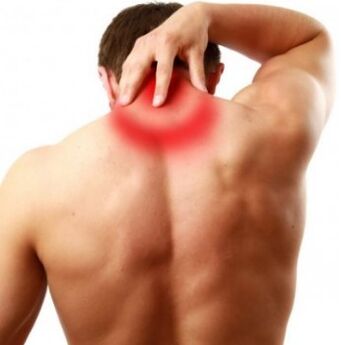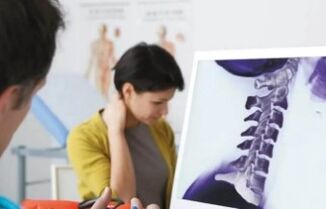Osteochondrosis is a spine disease, characterized by the development of changes in intervertebral disc cartilage and reactive processes in surrounding tissues.
Cervical osteochondrosis columnIt differs in its manifestations of thoracic and lumbar osteochondrosis.Symptoms of cervical osteochondrosis are associated with the anatomical characteristics of the cervical spine.The dimensions of the vertebrae of the cervical region are smaller than the size of the other departments.The cervical department is constantly experiencing a load, holding the head and, at the same time, is a lot of mobility.

The causes of osteochondrosis
The causes of disease development, first and foremost, are due to aging related to the age of the body and the destruction in the development of bones and cartilage.The following causes of osteochondrosis can also be called:
- violation of posture,
- reducing motor activity as a result of a sedentary lifestyle,
- Overweight, which is the result of metabolic disorders, has a load on intervertebral discs,
- hereditary factor,
- Long -term physical activity,
- Vertebral column abnormalities.
Uniform physical activity, adequate nutrition and a healthy lifestyle significantly reduce the likelihood of developing this disease and also reduces the effect on the overall well.
Symptoms of cervical spine osteochondrosis
The manifestations of cervical osteochondrosis differ from symptoms in another spine.This is due to the fact that cervical vertebrae have a different structure and are very close.Therefore, any displacement manifests itself by intense pain.In addition, a nervous beam and the arteries are often compressed in the cervical spine.
Cervical osteochondrosis of the spineIt is manifested by the following symptoms:
- Sensations of pain - Pain can be felt in different parts of the body.This is due to the fact that it holds the nerve endings and the muscles of the corresponding part of the body.
- Weakness in the upper limbs of the limbs, due to the tweezers of the nerve endings responsible for motor activity.
- Difficulties in turning your head, the emergence of a crisis of vertebrae in the cervical region due to changes in the intervertebral disc structure, the appearance of bone formations.
- Low hand sensitivity.
- Weakness and dizziness appear due to artery pinch, which guarantees blood and nutrition in the brain.
- Reduce hearing and vision - appears at the last stage of the disease, when blood circulation in the cerebellum is disturbed.
Signs of the cervical department of osteochondrosis
- Rine Syndrome - Characterized by a pinch of the nervous beam in the neck.It is manifested by serious pain that can be felt on the shoulders, spatula.
- Vertebrate Syndrome - Manifested by the stronger headaches, pain in the temples and back of the head.
- Reflex syndrome - characterized by intense pain in the cervical region, which can intensify with any movement of the head.The pain can move to the shoulder and chest.
- Cardinal Syndrome - Reminds an attack by Angina Pectoris, which is extremely difficult to determine.
The degree of development of cervical spine osteochondrosis
As it develops, the disease passes various stages.Each stage has its own characteristics and is characterized by certain resources.
- 1st stage.The fabric of the vertebrae-chrysny bones gradually begins to collapse.The symptoms of the disease are not noticeable.And often patients simply do not perceive them, but associate fatigue and pain with excess work and stress.
- Step 2. At height, the disc starts to decrease, the cracks appear in it.The patient experiences constant pain, weakness, numbness of the face.
- Stage 3. Disc drops begin to form, cervical vessels and muscles are damaged.There are complaints about dizziness, pain in the back of the head.
- 4th stage.The bone tissue that protects the vertebrae from the excessive load begins to grow as a result of which nerve endings are compressed.There is rigidity in movements, neighboring joints are damaged.
The dangers of cervical osteochondrosis
A large number of nerves and arteries are located in the cervical region, which provides nutrition to the brain.In case of violation of its work, the brain will not receive sufficient nutrition for normal functioning.This situation can violate a person's motor activity, cause limb pain as well as loss of coordination.
At an advanced stage of osteochondrosis, ischemia, stroke and many other diseases that are dangerous to human life can develop.
Therefore, when any symptoms associated with this disease appears, it is recommended to seek medical help.
Diagnosis of the cervical spine
The following types of diagnosis are used to examine spinal diseases:
- Image x -ray is an ineffective way to diagnose this disease,
- Magnetic resonance imaging (magnetic resonance imaging) shows bone structures, formed disc hernias and their sizes,
- CT (computed tomography) is ineffective compared to magnetic resonance imaging, because with the help of this diagnostic method, it is difficult to determine hernial sizes,
- Ultrasound duplex scan is used when total blood flow is disturbed.This examination shows the existing speed of blood flow as well as the presence of barriers on the way.
Treatment of cervical spine osteochondrosis

The treatment of cervical spine osteochondrosis should be performed in the complex, depending on the situation.A positive effect can be achieved thanks to a comprehensive and individual approach, which includes drug treatment, procedure physiotherapist, physiotherapy exercises, massage and traditional medicine are also used.
During the aggravation period, the treatment of cervical osteochondrosis of the spine aims to increase blood circulation to get rid of muscle cramps.In this case, agents are prescribed that improve blood flow, anti -inflammatory drugs and analgesics and vitamins complexes.
PHYSICAL EDUCATION OF THE MEDIA FOR OSTEOCONDROSIS OF THE CERVICAL REGION
Therapeutic gymnastics provides visible results and is less dangerous in the recovery phase.The principle of the action of physical therapy exercises is to restore blood flow into damaged parts of the body.Performing physical therapy exercises, the patient should not feel pain and inconvenience.
The set of exercises for the cervical spine is designed to strengthen the neck muscles and also acts as a prevention for the development of cervical osteochondrosis.
Massage for cervical spine osteochondrosis
Massage is performed to strengthen tone in the muscles and relieve pain.Depending on the stage of disease development, different massage methods are done.Classic massage techniques include:
- Tightening - This technique consists of the effect on the surface layers of the skin.The massage begins with a collar area and continues to clave and armpits.
- Tightening - In this case, the effect during massage occurs in the deepest layers of the skin.Bashening The neck with the thumb and the indicator perform movements to capture the skin, which resemble tightening.
- Encry - performed with the objective of warming and relaxing the skin to improve blood supply in the collar area of the cervical spine.
- Kneading - It has special restrictions as it affects the tissues deeply lying down.If this technique is performed incorrectly, the patient may be harmful.
In cases where the patient's feel of pain occurs only on one side, the massage should begin to present from the healthy part of the neck, moving gradually to the part of the cervical region where the pain appears.
Massage can be performed at home and in a medical institution.However, during your implementation, you should be very careful not to cause an exacerbation of the disease or not to do worse.
Prevention of cervical osteochondrosis
To avoid the occurrence and development of the disease, it is recommended to comply with the simple rules:
- bring a healthy lifestyle, exercise, regularly visit the pool;
- Diversify the diet of magnesium and calcium -rich foods;
- In the case of sedentary work, it is necessary to heat several times a day;
- To sleep, you should choose an orthopedic mattress and a comfortable pillow.






















